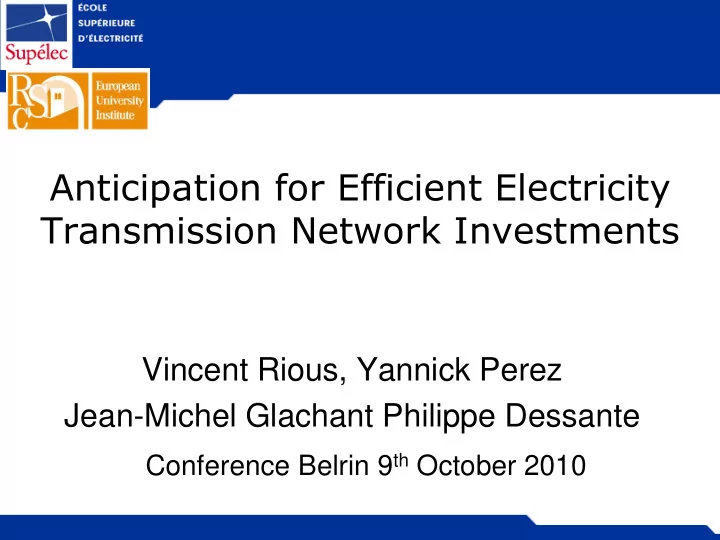

Anticipation for Efficient Electricity Transmission Network Investments Vincent Rious, Yannick Perez Jean-Michel Glachant Philippe Dessante Conference Belrin 9 th October 2010
Outline 2 • Motivation • Problem • Model • Illustration • Conclusion
Coordinated gen° and trans° investments by an integrated utility 3 Integrated Utility Easy to know when to build each investment considering the longest construction lead time
Unbundling and coordination need 4 Generation Time to Notional technology build (year) size (MW) Liberalised power system CCGT 2 800 >> Prompts investors to choose Wind onshore 2 25 generation technologies with short offshore 2 100 construction lead time Coal 4-5 150-1600 Nuclear 5-7 1600 Congestion while the network is not upgraded Right of way of powerlines facing increasing oppositions ~ 7 years to build a powerline from study to construction itself because of administrative agreement >> 5 years!
Two possible behaviors for the TSO 5 • Reactive behavior – Wait connection request to study opportunity for transmission investments • Proactive behavior – Anticipate connection request in areas with exploitable energy sources • Gas • Wind – Administrative procedures are already agreed when generators request for connection
Advantages & drawbacks of the two possible behaviors 6 • Reactive behavior Excessive congestion if CCGT or wind power involved while network is upgraded • Proactive behavior – No excessive congestion – But proactive behavior is costly because, if generation does not come, the TSO did • the study to upgrade the network • And the procedures to obtain the administrative agreement to build the line
Outline 7 • Motivation • Problem • Model • Illustration • Conclusion
Problem 8 • What is the efficiency of anticipating generation connection for the TSO in terms of minimization of the network cost? – No anticipation creates congestion for quite long period while network must be upgraded – But anticipation is costly if the anticipated generators do not eventually come We must arbitrate between these two costs
Outline 9 • Motivation • Problem • Model • Illustration • Conclusion
Sequence of investments with a reactive TSO 10 0 Year Construction Study, admin. proced. construction d Generation Transmission Investment Investment CW ( d ) CU ( d ) Excessive congestion Optimal value for network capacity
Costs faced by a reactive TSO 11 Congestion cost w ithout and after the network being u pgraded Generator invests does not invest Expected social cost TSO Probability p Probability 1- p waits for connection E C p re active TSO CW(d) + CU(d) of power plant 0 + 0 CW d CU d before studying and + I/(1+a) d p d upgrading I 1 a Transmission No congestion investment cost & no network investment
Sequence of investments with a proactive TSO 12 0 Year Construction Study, admin. proced. construction Generation and Network Investments CU (0)
Costs faced by a proactive TSO 13 Congestion cost with u pgrade as soon as the generator connects Generator invests does not invest Expected social cost TSO Probability p Probability 1- p waits for connection E C p proactive TSO of power plant a I + 0 p I CR 0 I + CU(0) before studying and I a 1 p upgrading Transmission No congestion cost investment cost Anticipation cost = network study + admin proced.
Condition for a proactive TSO to be efficient 14 • When is proactive as efficient as reactive? a p a lim d 1 a 1 CW d CU d CW 0 I p < p lim reactive TSO > proactive TSO p > p lim proactive TSO > reactive TSO The anticipation strategy is all the more efficient that p lim is small For a given a, p lim as function of d
Outline 15 • Motivation • Problem • Model • Illustration • Conclusion
“Probability limit” and condition for a proactive TSO 16
Outline 17 • Motivation • Problem • Model • Illustration • Conclusion
Conclusion 18 • A model to evaluate the efficiency of anticipating of power plants to minimize the cost of the network • Illustration on a simple realistic example with CCGT – Efficient to anticipate the connection of power plants for the TSO – Planning in advance network reinforcement – Reduce congestion cost
Future researches 19 • Variation of the cost of anticipating • Duplicate this study for wind farm • Interaction with regulatory actions • Use real option methods
Anticipation for Efficient Electricity Transmission Network Investments Thank you for your attention Questions ? Comments ? Vincent Rious, Yannick Perez, Jean-Michel Glachant Philippe Dessante Conference Berlin 8t h October 2010
Recommend
More recommend